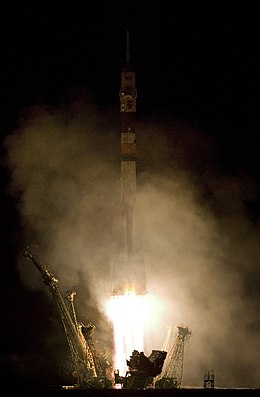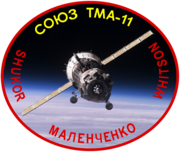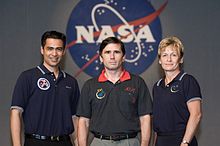
The Soyuz programme is a human spaceflight programme initiated by the Soviet Union in the early 1960s. The Soyuz spacecraft was originally part of a Moon landing project intended to put a Soviet cosmonaut on the Moon. It was the third Soviet human spaceflight programme after the Vostok (1961–1963) and Voskhod (1964–1965) programmes.
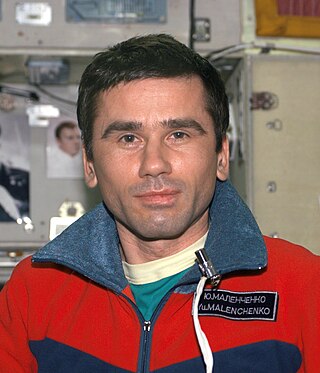
Yuri Ivanovich Malenchenko is a retired Russian cosmonaut. Malenchenko became the first person to marry in space, on 10 August 2003, when he married Ekaterina Dmitrieva, who was in Texas, while he was 240 miles (390 km) over New Zealand, on the International Space Station. As of December 2023, Malenchenko ranks third for career time in space due to his time on both Mir and the International Space Station (ISS). He is a former commander of the International Space Station.

Soyuz TMA-1, also catalogued as Soyuz TM-35, was a 2002 Soyuz mission to the International Space Station (ISS) launched by a Soyuz FG launch vehicle with a Russian-Belgian cosmonaut crew blasted off from the Baikonur Cosmodrome in Kazakhstan. This was the fifth Russian Soyuz spacecraft to fly to the ISS. It was also the first flight of the TMA-class Soyuz spacecraft. Soyuz TM-34 was the last of the prior Soyuz-TM spacecraft to be launched.

Soyuz TMA-10 was a human spaceflight mission using a Soyuz-TMA spacecraft to transport personnel to and from the International Space Station (ISS). The mission began at 17:31:09 UTC on April 7, 2007 when the spacecraft was launched from the Baikonur Cosmodrome by a Soyuz FG launch vehicle. Soyuz TMA-10 brought to the station two members of ISS Expedition 15 crew, along with one spaceflight participant. It remained at the space station as an escape craft until it was replaced by Soyuz TMA-11 in October 2007.

The Angkasawan program was an initiative by the Malaysian government to send a Malaysian to the International Space Station on board Soyuz TMA-11. The program was named after the Malay word for astronaut, Angkasawan. It resulted in Sheikh Muszaphar Shukor becoming the first Malaysian in space on 10 October 2007.

Soyuz TMA-12 was a Soyuz mission to the International Space Station (ISS) which was launched by a Soyuz FG rocket at 11:16 UTC on 8 April 2008. It docked to the Pirs module of the station on 10 April 2008. Landing occurred at 03:37 on 24 October. It was the first nominal landing in three missions, following separation failures on the Soyuz TMA-10 and 11 spacecraft.
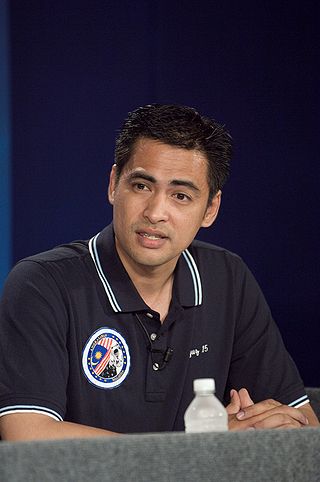
Sheikh Muszaphar Shukor Al Masrie bin Sheikh Mustapha is a Malaysian orthopaedic surgeon and spaceflight participant. He launched to the International Space Station aboard Soyuz TMA-11 with the Expedition 16 crew on 10 October 2007. Sheikh Muszaphar flew under an agreement with Russia through the Angkasawan program, and returned to Earth on 21 October 2007, aboard Soyuz TMA-10 with the Expedition 15 crew members, Fyodor Yurchikhin and Oleg Kotov.

Faiz bin Khaleed is a Malaysian military dentist with the Malaysian Armed Forces. In September 2006, he was selected as one of two final candidates to undergo astronaut training in Star City as part of the Angkasawan program. The other candidate was Sheikh Muszaphar Shukor.

Expedition 16 was the 16th expedition to the International Space Station (ISS). The first two crew members, Yuri Malenchenko and Peggy Whitson, launched on 10 October 2007, aboard Soyuz TMA-11, and were joined by spaceflight participant Sheikh Muszaphar Shukor, the first Malaysian in space.

Soyuz TMA-13 was a Soyuz mission to the International Space Station (ISS). The spacecraft was launched by a Soyuz-FG rocket at 07:01 GMT on 12 October 2008. It undocked at 02:55 GMT on 8 April 2009, performed a deorbit burn at 06:24, and landed at 07:16. By some counts, Soyuz TMA-13 is the 100th Soyuz spacecraft to be crewed.
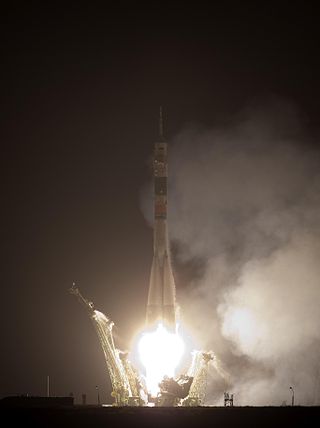
Soyuz TMA-17 was a human spaceflight mission to the International Space Station (ISS). TMA-17 crew members participated in ISS Expedition 22 and Expedition 23. The mission ended when the Soyuz TMA-17 capsule landed on 2 June 2010.

Soyuz TMA-18 was a 2010 Soyuz flight to the International Space Station (ISS). TMA-18 was the 105th crewed flight of a Soyuz spacecraft since the first crewed flight in 1967.

Soyuz TMA-19 was a crewed spaceflight to the International Space Station (ISS) and is part of the Soyuz programme. It was launched on 15 June 2010 carrying three members of the Expedition 24 crew to the International Space Station, who remained aboard the station for around six months. Soyuz TMA-19 was the 106th crewed flight of a Soyuz spacecraft, since the first mission which was launched in 1967. The spacecraft remained docked to the space station for the remainder of Expedition 24, and for Expedition 25, to serve as an emergency escape vehicle. It undocked from ISS and landed in Kazakhstan on 26 November 2010. It was the 100th mission to be conducted as part of the International Space Station programme since assembly began in 1998.
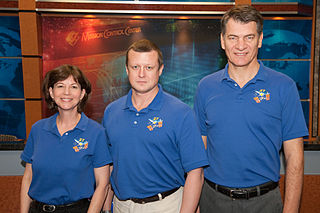
Soyuz TMA-20 was a human spaceflight to the International Space Station (ISS) and was part of the Soyuz programme. It lifted off from the Baikonur Cosmodrome in Kazakhstan on December 15, 2010, and docked with the ISS two days later. The three-person crew of Soyuz TMA-20 – Dmitri Kondratyev, Catherine Coleman and Paolo Nespoli – represented the ISS partner organizations of Roscosmos, NASA and the European Space Agency (ESA). Soyuz TMA-20's crew represented half of the members of Expedition 27; the other three members of the expedition arrived at the station on board Soyuz TMA-21 on April 6, 2011. The COSPAR ID of Soyuz TMA-20 was 2010-067A. It is ISS flight 25S.

Soyuz TMA-21 ("Gagarin") was a Soyuz flight to the International Space Station (ISS). It transported three members of the Expedition 27 crew to the ISS, and docked at the station on April 6, 2011. TMA-21 is the 109th flight of a Soyuz spacecraft, the first of which launched in 1967. The Soyuz remained attached to the space station as a lifeboat, throughout the remainder of Expedition 27 and through the end of Expedition 28, and returned to Earth on September 16, 2011.

Soyuz TMA-02M was a space mission that transported three members of the Expedition 28 crew to the International Space Station. TMA-02M was the 110th flight of a Soyuz spacecraft and the second flight of the improved Soyuz-TMA-M series. The Soyuz remained docked to the space station for the Expedition 28 increment to serve as a potential emergency escape vehicle.

Soyuz TMA-22 was a crewed spaceflight to the International Space Station (ISS). TMA-22 was the 111th flight of a Soyuz spacecraft, and transported three members of the Expedition 29 crew to the ISS. The spacecraft docked to the ISS on 16 November 2011, and remained docked to serve as an emergency escape vehicle until its undocking on 27 April 2012. Soyuz TMA-22 successfully landed in Kazakhstan on 27 April 2012 11:45 GMT.

Soyuz TMA-03M was a spaceflight to the International Space Station (ISS). It launched on 21 December 2011 from Site One at the Baikonur Cosmodrome, Kazakhstan, carrying three members of Expedition 30 to the ISS. TMA-03M was the 112th flight of a Russian Soyuz spacecraft, since the first in 1967, and the third flight of the modernised Soyuz-TMA-M version. The docking with the International Space Station took place at 19:19 Moscow Time on 23 December, three minutes ahead of schedule.

Soyuz TMA-08M, identified as Soyuz 34 or 34S by NASA, was a 2013 flight to the International Space Station. It transported three members of the Expedition 35 crew to the International Space Station. TMA-08M was the 117th flight of a Soyuz spacecraft, the first flight launching in 1967.
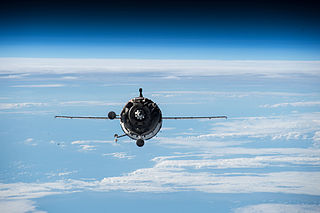
Soyuz TMA-16M was a 2015 flight to the International Space Station. It transported three members of the Expedition 43 crew to the station. TMA-16M was the 125th flight of a Soyuz spacecraft, the first having launched in 1967.
